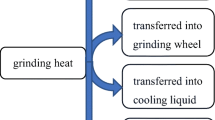Abstract
Grind-hardening is a new technology for steel part surface enhancing which uses thermal and mechanical composite effects on the parts in the grinding process. During the process, the workpiece surface generates hardened layer that improves the surface quality. Hardened layer may enhance fatigue strength, friction and wear properties, and corrosion resistance of parts significantly. Since component properties are influenced greatly by hardness penetration depth and its uniformity of parts, prediction of hardness penetration depth is significant to the practical engineering. First, the part is divided into cutting-in zone, middle zone, and cutting-out zone along length direction according to the characters of heat source strength changes. The mathematical models for segmented triangle heat source are carried out. Moreover, ANSYS is applied to simulate and analyze the distribution of temperature field and the change of instantaneous temperature in each zone of the grinding process. And the hardening penetration depth in each zone is predicted accordingly. Study of mechanism of depth uniformity is conducted emphatically in this paper. Results show that the change of heat intensity makes both ends of part not hardened during the grinding process. Hardening penetration depth increases gradually in the cutting-in zone and decreases gradually in the cutting-out zone. Meanwhile, the middle zone acquires deep and uniform hardened layer. Finally, comparison between predicted value and experimental value is carried on to verify the validity of source optimization model and reasonableness of prediction methods.
Similar content being viewed by others
References
Nguyen T, Zhang LC (2011) Realisation of grinding-hardening in workpieces of curved surfaces—part 1: plunge cylindrical grinding. Int J Mach Tools Manuf 51(4):309–319
Stohr R, Heinzel C (2002) Grinding-hardening with CBN. Abras Mag 6:22–30
Liu M, Nguyen T, Zhang L, Wu Q, Sun D (2015) Effect of grinding-induced cyclic heating on the hardened layer generation in the plunge grinding of a cylindrical component. Int J Mach Tools Manuf 89:55–63
Zhang L (2007) Grinding-hardening of steel surfaces: a focus review. Int J Abras Technol 1(1):3–36
Foeckerer T, Zaeh MF, Zhang OB (2013) A three-dimensional analytical model to predict the thermo-metallurgical effects within the surface layer during grinding and grind-hardening. Int J Heat Mass Transf 56:224–237
Salonitis K, Chryssolouris G (2007) Cooling in grinding-hardening operations. Int J Adv Manuf Technol 33:285–297
Brinksmeier E, Brockhoff T (1999) Surface heat treatment by using advanced grinding processes. La Metallurgia Italiana 91(4):19–23
Brockhoff T, Brinksmeier E (1999) Grind-hardening: a comprehensive view. CIRP Ann Manuf Technol 48(1):255–260
Salonitis K, Stavropoulos P, Kolios A (2014) External grind-hardening forces modeling and experimentation. Int J Adv Manuf Technol 70:523–530
Foeckerer T, Kolkwitz B, Heinzel C, Zaeh MF (2012) Experimental and numerical analysis of transient behavior during grind-hardening of AISI 52100. Prod Eng Res Dev 6:559–568
Zhang Y, Ge PQ, Be WB (2016) The study for variable grinding depth to control plane grind-hardening layer depth distribution. Int J Adv Manuf Technol 84:1269–1276
Alonso U, Ortega N, Sanchez JA, Pombo I, Izquierdo B, Plaza S (2015) Hardness control of grind-hardening and finishing grinding by means of area-based specific energy. Int J Mach Tools Manuf 88:24–33
Nguyen T, Zhang LC (2010) Grinding-hardening using dry air and liquid nitrogen: prediction and verification of temperature fields and hardened layer thickness. Int J Mach Tools Manuf 50:901–910
Xiu SC, Shi XL (2015) Transformation mechanism of microstructure and residual within hardening layer in PSHG. J Adv Mech Des Syst Manuf 9(3):1–13
Ortega N, Alonso U, Sanchez JA, Pombo I, Plaza S, Izquierdo B (2016) Modelling of the hardening and finishing stages of grind-hardened workpieces. Int J Adv Manuf Technol 82:435–449
Zaeh MF, Brinksmeier E, Heinzel C, Huntemann JW, Foeckerer T (2009) Experimental and numerical identification of process parameters of grind-hardening and resulting part distortions. WGP Ann Prod Eng 3:271–279
Xiu SC, Liu MH, Wei JH, Zhang XM (2015) Study on grinding strengthening and hardening mechanism under small depth of cut conditions. Int J Surf Sci Eng 9(6):479–492
Lavine AS (1988) A simple model for convective cooling during the grinding process. J Eng Ind Trans 110(1):1–6
Ma ZL, Han ZT, Du CL (2008) Simulation of temperature field of transverse feed grinding. Manuf Technol Mach Tool 10:40–42
Rowe WB, Black S, Mills B, Morgan MN, Qi H (1996) Grinding temperatures and energy partitioning. Proc R Soc Lond A, London, pp 1083–1104
Author information
Authors and Affiliations
Corresponding author
Rights and permissions
About this article
Cite this article
Guo, Y., Xiu, S., Liu, M. et al. Uniformity mechanism investigation of hardness penetration depth during grind-hardening process. Int J Adv Manuf Technol 89, 2001–2010 (2017). https://doi.org/10.1007/s00170-016-9234-8
Received:
Accepted:
Published:
Issue Date:
DOI: https://doi.org/10.1007/s00170-016-9234-8



